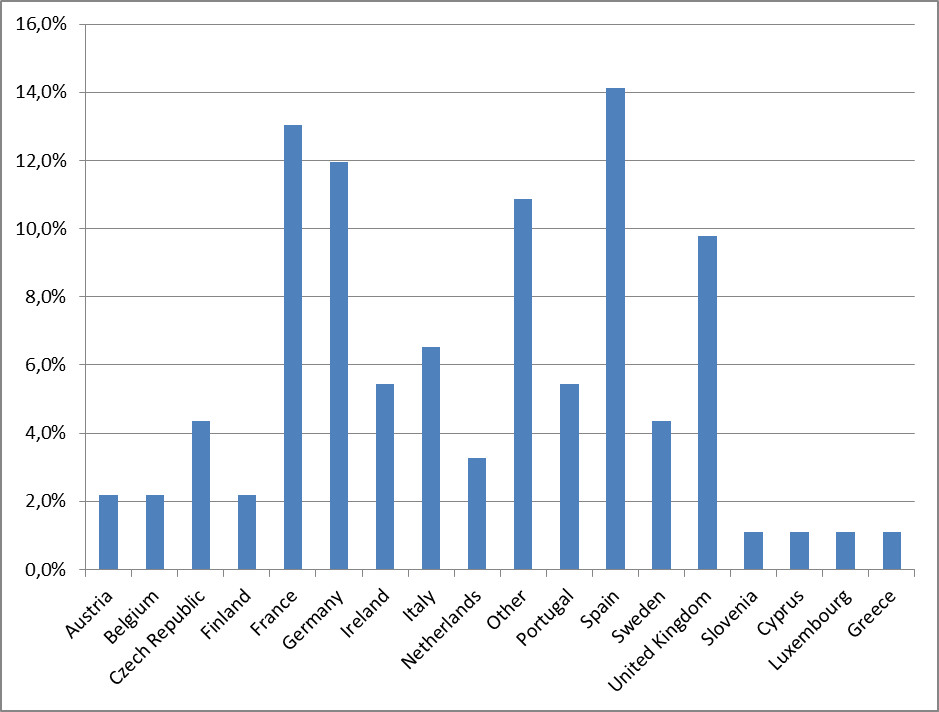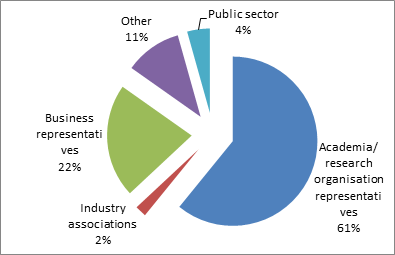Objectives of the consultation
The targeted stakeholder consultation aimed to gather input for defining a legal instrument for a procurement framework for High Performance Computing (HPC) by the end of 2017 in line with the Digital Single Market mid-term review. The replies obtained are helping the European Commission in the preparation of the new legal and financial instrument which would facilitate the implementation of EuroHPC goals.
Who replied to the consultation?
The online consultation gathered 92 replies from organisations in 17 Member States and 4 non-EU countries. The largest number of responses came from Spain (14.1%), France (13%), Germany (12%), UK (9.8%) and Italy (6.5%) totalling 55% of responses.
34% of responses came from the other Member States (Portugal, Sweden, Czech Republic, Netherlands, Ireland, Austria, Belgium, Finland, Slovenia, Cyprus, Luxembourg, Greece) and ~11% from the participating non-EU countries (Israel, Norway, Switzerland, USA).

Stakeholder categories were distributed as follows:
- 61% Academia / Research organisations
- 22% - Business representatives
- 4% - Public sector
- 2% - Industry associations
- 11% - Other stakeholders categories

This result confirms European actors' high awareness of HPC and it indicates HPC's potential for European industry, including SMEs.
Preliminary findings
85% of respondents found the current state of HPC in Europe problematic; 2% saw no problem, while 13% were undecided. The majority of those who saw a problem, pointed out these three issues as being the most relevant:
- Limited interaction between industry and academia on the exploitation of high-end computing systems, application codes and services especially in using HPC for industrial and service innovation (55.6%)
- Deep fragmentation of HPC programmes and uncoordinated activities and the lack of a common procurement framework result in wasted resources (55.6%)
- Europe's supercomputing capabilities depend on non-EU suppliers for critical technologies and systems (47.8%).
In addition to the lack of sufficient resources and insufficient access to HPC resources for science, a recurring perception was that too little emphasis is given on software developments given Europe's recognised world leading role in HPC applications.
Only ~2% of respondents found that no EU action should be taken to improve HPC in Europe, 15% were satisfied with current EU actions; 83% of respondents confirmed the need for EU action beyond the current level.
Those who favoured EU action beyond the current level made two arguments:
- EU coordination and cooperation of HPC initiatives is insufficient, resulting in strong fragmentation between current EU initiatives, individual Member States' and stakeholders' efforts.
- The EU is bound to trail its global competitors (USA, China) in this strategic field if it continues its fragmented efforts.
Next steps
A full synopsis report will proceed to a wrap-up of the entire structures dialogue and draw conclusions on these issues. It is planned to be published on the DSM website soon.
Related content
Report / Study | 11 January 2018
The 'targeted stakeholder consultation' on the Common European initiative on High Performance Computing (HPC) was held from 3 August to 5 September 2017. You will find below the responses of participants and stakeholders who gave their consent to publication as well as a synopsis report analysing the results of this public consultation.
